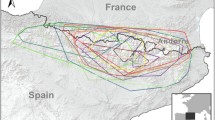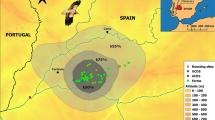Abstract
The post-fledging dependence period (PFDP) is one of the most critical stages in the life history of some avian species. Birds are particularly sensitive to mortality during this stage as they must learn essential skills, such as efficient locomotion, proficient food location and predator avoidance. Knowledge of the PFDP would provide valuable information for conservation management of endangered species, many of which experience high juvenile fatality rates. Post-fledging movements of five endangered Cape Vultures were recorded using Global Positioning System/Global System for Mobile communication telemetry in South Africa. Home range sizes, distances travelled from the nest and habitat use were determined over 11 months during the PFDP. Fledglings increased their home range progressively for the first 2 months, then exhibited a rapid increase in home range size associated with dispersal from their natal colony. Maximum net daily distance also rapidly increased following the dispersal period. A preference for protected areas and woody vegetation (representing cliff faces used for roosting) in terms of habitat use for foraging was evident. The knowledge of the movement and habitat use of juvenile Cape Vultures can aid in the effective conservation planning for the species. Conservation programs in identified areas can be focused on power line and wind-farm mitigation, areas of supplementary feeding and anti-poisoning events.
Zusammenfassung
Orstbewegungen nach dem Flüggewerden und die räumliche Ökologie des bedrohten Kapgeiers ( Gyps coprotheres )
Die Zeit direkt nach dem Flüggewerden ist einer der kritischsten Abschnitte im Leben einer Vogelart. In dem Stadium ist die Sterblichkeitsrate der Vögel besonders hoch, da sie in dann ganz wesentliche Fähigkeiten wie z.B. die effiziente Fortbewegung, das geschickte Auffinden von Nahrung sowie das Vermeiden von Feinden erlernen müssen. Genaueres Wissen über diesen Lebensabschnitt böte dem Management für den Schutz bedrohter Arten wertvolle Informationen, da viele dieser Arten in ihrer juvenilen Lebensphase eine hohe Sterblichkeitsrate aufweisen. Für fünf gefährdete Kapgeier zeichneten wir in Südafrika nach dem Flüggewerden die Ortsbewegungen mittels GPS/GSM-Telemetrie auf. Über elf Monate hinweg wurde während dieser Lebensphase ihr Aktionsradius, die Strecken zwischen Nest und genutztem Habitat, aufgezeichnet. In den ersten beiden Monaten erweiterten die flüggen Jungtiere kontinuierlich ihren Aktionsradius; dann vergrößerten sie ihn rapide, verbunden mit der Ausbreitung weg von ihrer Brutkolonie. Im Verlauf dieser Ausbreitung vergrößerte sich rasch auch die maximale tägliche Entfernung von der Kolonie. Bei der Nahrungssuche zeigten sie eine klare Präferenz für Naturschutzgebiete und für Gehölzvegetation (mit steilen Felswänden zum Übernachten). Genauere Informationen über die Ortsbewegungen und Habitatnutzung junger Kapgeier kann bei der Planung effektiver Schutzmaßnahmen für diese Art helfen. Programme zu ihrem Schutz können sich in ausgewiesenen Gebieten auf die Entschärfung von Hochspannungsleitungen und Windkraftanlagen konzentrieren sowie auf Gebiete für zusätzliche Fütterung und die Bekämpfung des Auslegens von Giftködern.




Similar content being viewed by others
References
Allan D (2015) A conservation assessment of Gyps coprotheres species. In: Taylor M, Peacock F, Wanless R (eds) The Eskom Red Data Book of Birds of South Africa, Lesotho and Swaziland. BirdLife South Africa, Johannesburg
BirdLife International (2015) Gyps coprotheres. The IUCN Red List of Threatened Species 2015. http://dx.doi.org/10.2305/IUCN.UK.2015
BirdLife South Africa (2015) Colleywobbles Vulture Colony. http://www.birdlife.org.za/get-involved/join-birdlife-south-africa/item/230-sa088-collywobbles-vulture-colony. Accessed: 6 June 2017
Boshoff A, Minnie J (2011) On the role of the shape and size of foraging area, and colony size, in selecting critical areas for Cape Griffon Gyps coprotheres conservation action. Vulture News 61:4–15. https://doi.org/10.4314/vulnew.v61i1.1
Boshoff AF, Piper S, Michael M (2010) On the distribution and breeding status of the Cape Griffon Gyps coprotheres in the Eastern Cape Province, South Africa. Ostrich 80:85–92. https://doi.org/10.2989/ostrich.2009.80.2.4.831
Brown C, Piper S (1988) Status of Cape Vultures in the Natal Drakensberg and their cliff site selection. Ostrich 59:126–136. https://doi.org/10.1080/00306525.1988.9633714
Byers CR, Steinhorst RK, Krausman PR (1984) Clarification of a technique for analysis of utilization-availability data. J Wildl Manage 48:1050–1053. https://doi.org/10.2307/3801467
Delgado MM, Penteriani V, Nams VO (2009a) How fledglings explore surroundings from fledging to dispersal. A case study with Eagle Owls Bubo bubo. Ardea 97:7–15. https://doi.org/10.5253/078.097.0102
Delgado MM, Penteriani V, Nams VO, Campioni L (2009b) Changes of movement patterns from early dispersal to settlement. Behav Ecol Sociobiol 64:35–43. https://doi.org/10.1007/s00265-009-0815-5
Donázar JA, Ceballos O (1990) Post-fledging dependence period and development of flight and foraging behaviour in the Egyptian Vulture Neophron percnopterus. Ardea 78:387–394
Dwyer JF (2010) Ecology of non-breeding and breeding Crested Caracaras (Caracara cheriway) in Florida. PhD thesis, Virginia Polytechnic Institute and State University
Gilbert M, Virani MZ, Watson RT, Oaks JL, Benson PC, Khan AA, Ahmed S, Chaudhry J, Arshad M, Mahmood S, Shah QA (2002) Breeding and mortality of Oriental White-backed Vulture Gyps bengalensis in Punjab Province. Pakistan Bird Conserv Int 12:311–326. https://doi.org/10.1017/s0959270902002198
Harel R, Horvitz N, Nathan R (2016) Adult vultures outperform juveniles in challenging thermal soaring conditions. Sci Rep 6:27865. https://doi.org/10.1038/srep27865
IBM Corp (2016) IBM SPSS statistics for Windows, version 24.0. IBM, Armonk
International Union for Conservation of Nature and Natural Resources and United Nations Environment Programme’s World Conservation Monitoring Centre (UNEP-WCMC) (2016) The World Database on Protected Areas (WDPA). UNEP-WCMC, Cambridge, UK. http://www.protectedplanet.net
Johnson MD (2007) Measuring habitat quality: a review. Condor 109:489–504. https://doi.org/10.1650/8347.1
Kane A, Wolter K, Neser W, Kotze A, Naidoo V, Monadjem A (2016) Home range and habitat selection of Cape Vultures Gyps coprotheres in relation to supplementary feeding. Bird Study 63:387–394. https://doi.org/10.1080/00063657.2016.1214105
Krüger S, Amar A (2017) Insights into post-fledging dispersal of Bearded Vultures Gypaetus barbatus in southern Africa from GPS satellite telemetry. Bird Study 64:125–131. https://doi.org/10.1080/00063657.2017.1295019
Krüger S, Reid T, Amar A (2014) Differential range use between age classes of Southern African Bearded Vultures Gypaetus barbatus. PLoS One 9:e114920. https://doi.org/10.1371/journal.pone.0114920
Laver PN, Kelly MJ (2008) A critical review of home range studies. J Wildl Manage 72:290–298. https://doi.org/10.2193/2005-589
López-López P, Garcὶa-Ripollés C, Urios V (2014) Food predictability determines space use of endangered vultures: implications for management of supplementary feeding. Ecol Appl 24:938–949. https://doi.org/10.1890/13-2000.1
Loss SR, Will T, Marra PP (2015) Direct mortality of birds from anthropogenic causes. Annu Rev Ecol Evol Syst 46:99–120. https://doi.org/10.1146/annurev-ecolsys-112414-054133
McFadzen ME, Marzluff JM (1996) Mortality of Prairie Falcons during the fledging-dependence period. Condor 98:791–800. https://doi.org/10.2307/1369859
Morrison JL, Wood PB (2009) Broadening our approaches to studying dispersal in raptors. J Raptor Res 43:81–89. https://doi.org/10.3356/jrr-08-33.1
Mundy P, Butchart D, Ledger J, Piper S (1992) The vultures of Africa. Acorn, Randburg
Negro JJ, Hiraldo F, Donázar JA (1997) Causes of natal dispersal in the Lesser Kestrel: inbreeding avoidance or resource competition? J Anim Ecol 66:640–648. https://doi.org/10.2307/5917
Ogada DL, Keesing F, Virani MZ (2012) Dropping dead: causes and consequences of vulture population declines worldwide. Ann N Y Acad Sci 1249:57–71. https://doi.org/10.1111/j.1749-6632.2011.06293.x
Péron C, Grémillet D (2013) Tracking through life stages: adult, immature and juvenile autumn migration in a long-lived seabird. PLoS One 8:e72713. https://doi.org/10.1371/journal.pone.0072713
Pfeiffer MB, Venter JA, Downs CT (2015a) Identifying anthropogenic threats to Cape Vultures Gyps coprotheres using community perceptions in communal farmland, Eastern Cape Province, South Africa. Bird Conserv Int 25:353–365. https://doi.org/10.1017/s0959270914000148
Pfeiffer MB, Venter JA, Downs CT (2015b) Foraging range and habitat use by Cape Vulture Gyps coprotheres from the Msikaba colony, Eastern Cape Province, South Africa. Koedoe 57:1–11. https://doi.org/10.4102/koedoe.v57i1.1240
Pfeiffer MB, Venter JA, Downs CT (2017) Observations of microtrash ingestion in Cape Vultures in the Eastern Cape. South Africa African Zool 52:65–67. https://doi.org/10.1080/15627020.2016.1270172
Phipps WL, Wolter K, Michael MD, MacTavish LM, Yarnell RW (2013) Do power lines and protected areas present a catch-22 situation for Cape Vultures (Gyps coprotheres)? PLoS One 8:e76794. https://doi.org/10.1371/annotation/f4701461-4b42-4744-8338-0c15c9065800
Piper S (1994) Mathematical demography of the Cape Vulture. PhD thesis, University of Cape Town
Piper SE, Mundy PJ, Ledger JA (1981) Estimates of survival in the Cape Vulture, Gyps coprotheres. J Anim Ecol 50:815–825. https://doi.org/10.2307/4139
Piper SE, Mundy PJ, Vernon CJ (1989) An ageing guide for the Cape Vulture. Modoqua 16:105–110
R Core Team (2016) R: a language and environment for statistical computing. R Foundation for Statistical Computing, Vieanna. URL https://www.R-project.org/
Robertson AS (1985) Observations on the post-fledging dependence period of Cape Vultures. Ostrich 56:58–66. https://doi.org/10.1080/00306525.1985.9639570
Sandgren C, Hipkiss T, Dettki H, Ecke F (2014) Habitat use and ranging behaviour of juvenile Golden Eagles Aquila chrysaetos within natal home ranges in boreal Sweden. Bird Study 61:9–16. https://doi.org/10.1080/00063657.2013.857387
Signer J, Balkenhol N (2015) Reproducible home ranges (rhr): a new, user-friendly R package for analyses of wildlife telemetry data. Wildl Soc Bull 39:358–363. https://doi.org/10.1002/wsb.539
South African National Botanical Institute (SANBI) (2014) National land cover database. SANBI, Pretoria, South Africa
Todd LD, Poulin RG, Wellicome TI, Brigham RM (2003) Post-fledging survival of Burrowing Owls in Saskatchewan. J Wildl Manage 67:512–519. https://doi.org/10.2307/3802709
Vernon CJ (1998) The Cape Vulture at Colleywobbles: 1977–1997. Ostrich 70:200–202. https://doi.org/10.1080/00306525.1999.9634236
Weston ED, Whitfield DP, Travis JMJ, Lambin X (2013) When do young birds disperse? Tests from studies of Golden Eagles in Scotland. BMC Ecol. https://doi.org/10.1186/1472-6785-13-42
Wiens JD, Noon BR, Reynolds RT (2006) Post-fledging survival of Northern Goshawks: the importance of prey abundance, weather, and dispersal. Ecol Appl 16:406–418. https://doi.org/10.1890/04-1915
Yamaç E, Bilgin CC (2012) Post-fledging movements of Cinereous Vultures Aegypius monachus in Turkey revealed by GPS telemetry. Ardea 100:149–156. https://doi.org/10.5253/078.100.0206
Acknowledgements
The Endangered Wildlife Trust are thanked for providing the necessary training and equipment. Thomas River Conservancy, P. Miles, R. and K. Wardle, H. and M. Neethling and Eskom are thanked for assistance, especially with housing, during fieldwork. H. Payne, T. Caine, V. Thabethe, C. Fritsch, M. Small, P. Gibson, J. Greef, B. Hoffman, S. McPherson, A. Bowe, B. DePreez, D. Mafuso, A. Harvey, R. Stretto, K. Lindner, T. van der Meer, P. Singh, M. Drabik-Hamshare and the community of Colleywobbles are thanked for their assistance with fieldwork. The Rufford Foundation, Gay Langmuir bursary, BirdLife South Africa, National Research Foundation, A. and M. Jooste, Fairfield Tours, Eastern Cape Parks and Tourism Agency, Eastern Cape Department of Economic Development, Environmental Affairs and Tourism, Nelson Mandela University and the University of KwaZulu-Natal provided financial support. We thank the reviewers for their comments, which greatly improved the manuscript.
Author information
Authors and Affiliations
Corresponding author
Ethics declarations
Conflict of interest
The authors declare that they have no conflict of interest.
Ethical approval
All applicable international, national, and/or institutional guidelines for the care and use of animals were followed. The procedures were approved by the University of KwaZulu-Natal Ethics Committee. Permits for the capture and handling of vultures and the fitting of tracking devices were granted by the Department of Environmental Affairs through the Threatened or Protected Species permit (permit number:29551).
Additional information
Communicated by N. Chernetsov.
Electronic supplementary material
Below is the link to the electronic supplementary material.
10336_2018_1564_MOESM2_ESM.tif
Fig A1 Movement of five fledged Cape Vultures once independent of parental influence from Colleywobbles Vulture Colony, Eastern Cape, South Africa (TIFF 25508 kb)
Rights and permissions
About this article
Cite this article
Martens, F.R., Pfeiffer, M.B., Downs, C.T. et al. Post-fledging movement and spatial ecology of the endangered Cape Vulture (Gyps coprotheres). J Ornithol 159, 913–922 (2018). https://doi.org/10.1007/s10336-018-1564-x
Received:
Revised:
Accepted:
Published:
Issue Date:
DOI: https://doi.org/10.1007/s10336-018-1564-x




